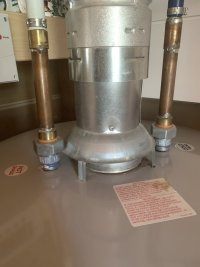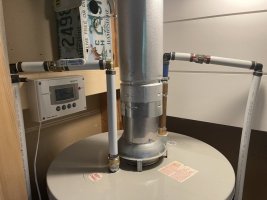I know this is an older thread, but better than starting a new one, right?
I just replaced the anode rod in my Bradford White heater (integrated with the hot outlet) and have realized I made an error. This is at a seasonal cottage, off grid, with a propane B-vent heater.
I got rid of the dielectric union not really knowing what I was doing and went straight in with the 3/4" PEX to a brass fitting on the galvanized nipple of the anode rod.
I realize now that I should have at least 18" of copper to protect the PEX from the flue heat and going back to copper means I guess I need to put a dielectric union back. Like the photo Terry posted earlier, my 9 year old union and outlet of the anode rod was rusty and crusty.
The union is a nice idea for future servicing, but this 9 year old heater will likely be replaced with a different model next time around, so I'll have to redo the supply lines I expect anyway. So I'm not overly fussed on the convenience of union fittings for service.
Is consensus that those corrugated flex lines are the best option when going from the heater to PEX supply lines?
Photos of my fittings attached. The image with the two unions in place is the original install with copper done by a 'professional' local plumber - copper shorter than it should be and not the neatest installation. I redid the hot when I did the anode rod but haven't done the cold supply yet.


